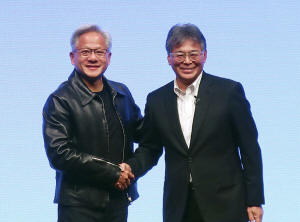|
“The AI industrial revolution has already begun. Building the
infrastructure to power it is essential in Japan and around the
world,” Nvidia Chief Executive Jensen Huang said, hugging his
Fujitsu counterpart Takahito Tokita on stage.
“Japan can lead the world in AI and robotics,” Huang told
reporters at a Tokyo hotel.
The companies will work together on building what they called
“an AI infrastructure,” or the system on which the various
futuristic AI uses will be based, including health care,
manufacturing, the environment, next-generation computing and
customer services. The hope is to establish that AI
infrastructure for Japan by 2030.
It initially will be tailored for the Japanese market,
leveraging Fujitsu’s decades-long experience here, but may later
expand globally, and will utilize Nvidia’s GPUs, or graphics
processing units, which are essential for AI, according to both
sides.
The two executives did not outline specific projects or give a
monetary figure for planned investments. But exploring a
collaboration in AI for robots with Yaskawa Electric Corp., a
Japanese machinery and robot maker, was noted as a possible
example. AI will be constantly evolving and learning, they said.
Fujitsu and Nvidia have been working together on AI, speeding up
manufacturing with digital twins and robotics to tackle aging
Japan’s labor shortages.
Tokita said the companies were taking a “humancentric” approach
aimed at keeping Japan competitive.
“Through our collaboration with Nvidia, we aim to create new,
unprecedented technologies and contribute to solving even more
serious social issues,” said Tokita.
All contents © copyright 2025 Associated Press. All rights reserved

|
|




